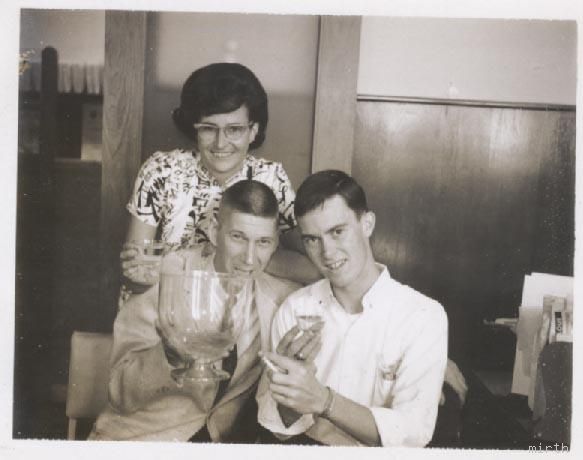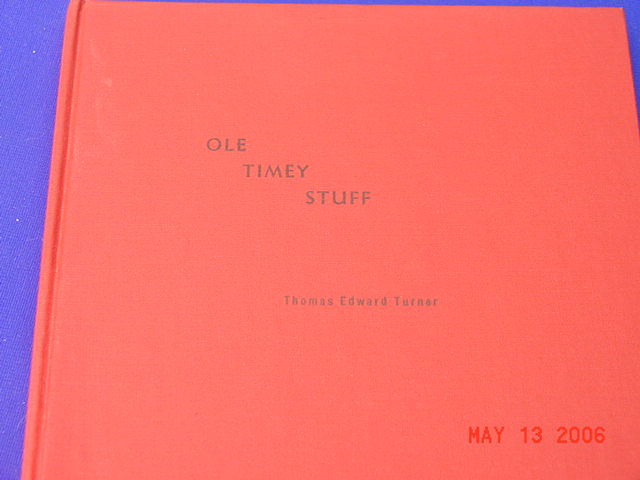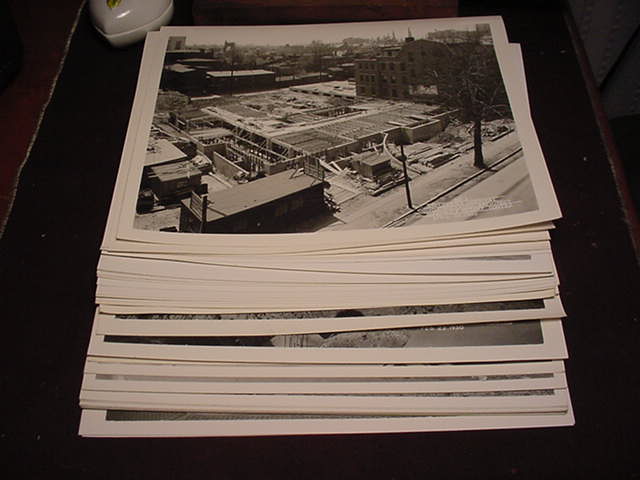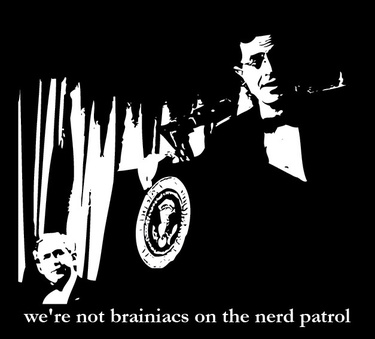Schwarz
View current page
...more recent posts
Sixties architects wanted us to live like aliens. Our correspondent spies a parallel universe
Vision, vision, vision, it’s everywhere. Can’t move for it. Architects are living in one of those all-too-brief moments in which the world seems to be swimming with fat wallets — cities, Middle Eastern oil states, capitalist dictatorships — with the means and the egos to indulge in fantastical visions.Not in Britain, naturally. We prefer to get our visionary fantasies in the sale aisle at Matalan. No, it’s in China, of course, and Dubai, but also in culturally adventurous continental Europe, and even in the once architecturally cautious America, that experimentation is flourishing.
Next week a major exhibition, Future City: Experiment and Utopia in Architecture 1956-2006, opens at the Barbican. This vast survey of the avant-garde since the Second World War has been thrillingly designed by the modern-day experimentalists Foreign Office Architects as a labyrinthine city within what is the last old-school utopian complex built in Britain. Almost all the (living) architects in the show are building, and on a scale: FOA are co-designing the 2012 Olympic Park, if the shindig’s accountants allow them; Coop Himmelblau are realising their Sixties fantasy Cloud as a show complex for BMW in Munich; America’s king of crazy shapes Thom Mayne last year won architecture’s highest honour, the Pritzker Prize.
We can chuckle at the models’ fashions in the Smithsons’ House of the Future, the Austin Powers-style inflatable cells Haus-Rucker-Co thought of to expand Manhattan. But these dreams are coming true. There’s a market for Utopias these days. And yet they all began with one man.
Constant Niewenhuys died in August, at the age of 85. There were few obituaries beyond his home country, the Netherlands. True, the man hadn’t exactly been front-page news for a decade or three. But still, this was the intellectual leader of the Provos, those pot-smoking anarchists whose artsy pranks in the 1960s ushered in the stereotype of liberal, libertarian Netherlands.
Constant co-founded the Situationiste Internationale, too, Jean-Luc Godard’s “children of Marx and Coca-Cola”, inspiration for every sulky counter-cultural movement from Beatniks through May 1968 and punk to the anti-globalisation protestors. The man was also a leading light of CoBrA, whose paintings — great childlike scrawls designed to put a bat up the nightdress of bourgeois society — are today the kind more admired by art theoreticians than by anyone with eyes in their head. And he also happened to be the most influential architect since the war.
Of course you’ve never heard of him. The man didn’t lay a brick in his entire life. But his one great conceptual work, New Babylon, was so powerful a vision of the future, the true heir to great architectural fantasists on paper from Piranesi to Sant’Elia, that there are few architects since who don’t owe him an intellectual debt. New Babylon begat the swirling forms of Frank Gehry and Zaha Hadid, the technopop of Archigram and Cedric Price, the playful naivety of Will Alsop, even the pragmatic high-tech of Richard Rogers and Norman Foster, and certainly the provocations of Rem Koolhaas.
joan jet
Muayad Muhsin was both inspired and enraged by a photo of U.S. Defense Secretary Donald H. Rumsfeld slumped on a seat with his army boots up in front of him.
thanks much to tom for jump-starting my artists page. basically, he used his main page as a template for mine. i will be filling in some older work with installation shots from shows. more recent work will follow too.
But now Mr. Chihuly is in the midst of a hard-edged legal fight in federal court here over the distinctiveness of his creations and, more fundamentally, who owns artistic expression in the glass art world.
Mr. Chihuly has sued two glass blowers, including a longtime collaborator, for copyright infringement, accusing them of imitating his signature lopsided creations, and other designs inspired by the sea.
"About 99 percent of the ocean would be wide open," Mr. Chihuly said in an interview. "Look, all I'm trying to do is to prevent somebody from copying me directly."
The glass blowers say that Mr. Chihuly is trying to control entire forms, shapes and colors and that his brand does not extend to ancient and evolving techniques derived from the natural world.
"Just because he was inspired by the sea does not mean that no one else can use the sea to make glass art," said Bryan Rubino, the former acolyte named in the suit who worked for Mr. Chihuly as a contractor or employee for 14 years. "If anything, Mother Nature should be suing Dale Chihuly."
The suit, rare in art circles, offers a sometimes unflattering glimpse at how high-powered commercial artists like Mr. Chihuly work. The two glass blowers say that he has very little to do with much of the art, and that he sometimes buys objects and puts the Chihuly name on them, a contention that Mr. Chihuly strongly denies.
Marcel Duchamp has emerged as the most influential artist in the UK. The French conceptualist who famously placed a urinal in a New York gallery in 1917 and declared “this is art”, has come top of our survey of students from 11 of the leading art schools in the UK. We spoke to over 320 students and asked them which three artists, living or dead, had inspired them most and have had the greatest influence on their work. Using their responses we compiled a ranking of the artists who have had the most impact on the next generation of British practitioners (right). Duchamp is followed by other 20th-century giants Picasso, Bacon, and Matisse.
The British painter Lucian Freud, 83, who comes fifth, is the highest ranking living artist. The only other living artists to make it into the top ten are Tracey Emin, 42, in joint eighth place with Salvador Dalí (her contemporary, Damien Hirst, comes in at number 19), and Bruce Nauman, 64, at number nine, whose work is currently on show at Tate Liverpool (until 28 August).
The list
1 Marcel Duchamp
2 Pablo Picasso
3 Francis Bacon
4 Henri Matisse
5 Lucian Freud
6 Philip Guston
7 Egon Schiele
8= Salvador Dalí
Tracey Emin
9= Joseph Beuys
Bruce Nauman
10 Gustav Klimt
11 Alberto Giacometti
12 Andy Warhol
13 Paula Rego
14=Jenny Saville
Luc Tuymans
15=Martin Creed
16=Louise Bourgeois
David Hockney
17= Andy Goldsworthy
Claude Monet
Vincent Van Gogh
18= Frida Kahlo
Gerhard Richter
19= Jean-Michel Basquiat
Damien Hirst
Piet Mondrian
Charles Rennie Mackintosh
20= Eva Hesse
Mike Kelley
David Shrigley
21= Marlene Dumas
Paul McCarthy
22= Francis Alys
Caravaggio
Anselm Kiefer
Edvard Munch
23= Felix Gonzales-Torres
Donald Judd
Anish Kapoor
24=Matthew Barney
Patrick Caulfield
Cézanne
Chuck Close
Olafur Eliasson
Agnes Martin
Henry Moore
25=Joseph Cornell
Martin Parr
26= Banksy
Cornelia Parker
27= Goya
Rebecca Horn
Kathe Kollwitz
Leonardo Da Vinci
Edouard Manet
Laszlo Moholy-Nagy
Jackson Pollock
Robert Rauschenberg Pipilotti Rist
James Turrell
Gillian Wearing
Rachel Whiteread
Christopher Wool
28=Sybil Andrews
Vija Celmins
El Greco
Jeff Koons
Sol LeWitt
Michelangelo
Grayson Perry
Antoni Tŕpies
Jack Vettriano
29= Alexander Calder
Caspar David Friedrich
Barbara Hepworth
Richard Long
Rembrandt
Cy Twombly
Velázquez
Bill Viola
30= David Batchelor
Sophie Calle
Lygia Clark
Peter Doig
Peter Fischli and
David Weiss
Max Ernst
Eric Fischl
Patrick Heron
William Hogarth
Wassily Kandinsky
Ian Kiaer
Georgia O’Keeffe
Tony Oursler
Fiona Rae
Mark Rothko
Gregor Schneider
Tino Sehgal
Robert Smithson
Wolfgang Tillmans
J.M.W. Turner
Keith Tyson
Jeff Wall
31= Diane Arbus
Umberto Boccioni
Peter Chang
Jake and Dinos Chapman
Willem De Kooning
William Eggleston
Ilya Kabakov
Kasimir Malevich
Man Ray
Mike Nelson
Jockum Nordström
Blinky Palermo
Cindy Sherman
Sir Stanley Spencer
Jessica Stockholder
Vermeer
Edouard Vuillard
Rebecca Warren
Richard Wentworth
Whistler
Richard Wright
32= Josef Albers
Helena Almeida
Craigie Aitchison
Bobby Baker
Luis Barragan
Bernini
Tony Bevan
William Blake
Ross Bleckner
David Bomberg
Martin Boyce
Boyle Family
Marcel Broodthaers
Fred Brown
Glenn Brown
Pedro Cabrita Reis
Maurizio Cattelan
Helen Chadwick
Marc Chagall
Hussein Chalayan
Christo and Jeanne-Claude
Victor Cirefice
Melanie Counsell
Raoul De Keyser
Jeremy Deller
Thomas Demand
Richard Diebenkorn
Stan Douglas
Albrecht Dürer
Joan Eardley
Denise Findlay
Urs Fischer
Hamish Fulton
Isa Genzken
Laura Godfrey-Isaacs
Michel Gondry
Patrick Gould
Angela Grossman Giovanni Antonio
Guardi
Frans Hals
John Hilliard
Robert Hodgins
Howard
Hodgkin
Dan Holdsworth
Carsten Holler
Roni Horn
Robert Irwin
Arne Jacobsen
Thomas Joshua
Cooper
William Kentridge
Sophie Kerr
Jim Lambie
Michael Landy
Wyndham Lewis
Magritte
Christian Marclay
Roberto Matta
Gordon Matta-Clark
Ana Mendieta
Michael Elmgreen and Ingar Dragset
Jeremy Millar
Alexandra Mir
Joan Miró
Shigeru Miyamoto
William Morris
Yoshimoto Nara
David Nash
Nolde, Emil
Nurminen, Maria
Opie, Julian
Oppenheim, Meret
Orozco, Gabriel
Packer, Jayne
Patterson, Richard
Paxton, Adam
Perryman, Jane
Piper, Adrian
Pomar, Julio
Portinari, Candido
Rayson, David
Rhodes, Zandra
Rodin, Auguste
Roversi, Paolo
Ruscha, Ed
Ryman, Robert
Santiago, Sierra
Scarpa, Carla
Schiaparelli, Elsa
Schorr, Collier
Serrano, Andres
Steadman, Ralph
Tanada, Koji
Tao, Shi
Tiravanija, Rirkrit
Uglow, Ewan
Van Dyck
Venelman, Tom
Vionnet, Madeleine
von Hausswollf, Annika
Wenders, Wim
West, Franz
Woodman, Francesca
33= Abts, Tomma
Acconci, Vito
Adams, Ansel
Allington, Edward
Almond, Darren
Alto, Alva
Amer, Ghada
Anderson, Wes
Applebroog, Ida
Augustine Ingres, Jean
Ayres, Gillian
Baek, Nam-Jun
Bailey, Christopher
Balla, Giacomo
Barlow, Phyllida
Battista Alberti, Leon
Bausch, Pina
Beardsley, Aubrey
Benner, Guy
Blahnik, Manolo
Bock, John
Bosch, Hieronymus
Boucher, Francois
Brancusi, Constantin
Braque, Georges
Broadhead, Caroline
Broumas, Olga
Brownjohn, Robert
Bruegel, Pieter
Burri, Alberto
Burroughs, William
Cage, John
Cage, Johne
Cardiff, Janet
Carrington, Leonora
Catling, Brian
Chain, Kai
Charlton, Alan
Christ, Jesus
Clemente, Franceco
Cocteau, Jean
Coldstream, William
Cole, Nathan
Coleman, James
Condo, George
Cook, Nigel
Cooper Clarke, John
Copley, Singleton
Cran, Chris
Crewdson, Gregory
Csorgo, Attila
Currin, John
Dalwood, Dexter
Davenport, Ian
David, Jacques-Louis
Davis, Tom
de Chirico, Giorgio
de la Rocha, Zack
Deakin, John
Dean, Tacita
Degas, Edgar
Dibbets, Jan
Dot Zero, One
Duncan, Isidora
Durham, Jimmie
E. Kano, Francis
Ellis, Francis
Ende, Edgar
Ernst, Max
Evju, Kristian
Flavin, Dan
Flemming, Peter
Fletcher, Alan
Franks, Tony
Friedman, Tom L
Frink, Elisabeth
Gabo, Naum
Gehry, Frank
Gober, Robert
Gormley, Anthony
Gould, Glenn
Graham, Rodney
Gross, Katarina
Gursky, Andreas
Hamilton, Anna
Hamilton, Richard
Hardstaff, Johnny
Hart, Tony
Hatoum, Mona
Havrv, Mankiei
Hawkinson, Tim
Heron, Susanna
Herzog & De Meuron
Hiller, Susan
Hoch, Hannah
Hogg, Dorothy
Holzer, Jenny
Hongtu, Zhang
Hopper, Edward
Horowitz, Jonathan
Hoyland, Francis
Jacir, Emily
James, Gillray
John, Gwen
Johns, Jasper
Jones, Zebedee
Jonze, Spike
Joyce, James
Judd, Donald
Junepiak, Nam
Junger, Herman
Kankerua, Marso
Kaprow, Allan
Katchadourian, Nina
Kawakubo, Rei
Kawamata, Tadashi
Keats, Ezra Jack
Kelly, Ellsworth
Kelly, Mary
Kelly, Patrick
Kilimnik, Karen
Kippenberger, Martin
Kirkeby, Per
Klaus, Jack
Klein, Frans
Knapp, Stefan
Kokosalaki, Sophia
Kosuth, Joseph
Kripe, Tony
Krystufek, Elke
Larbalestier, Simon
Larner, Liz
Lasker, Jonathan
Latham, John
Leapman, Edwina
Lee, Helen
Leibowitz, Annie
Lewis, Anna
Lichenstein, Roy
Livick, Steven
London, Jack
Lopez, Antonio
Lorrain, Claude
Lynch, Bronagh
MacLau, Jackson
Majerus, Michel
Mallarme, Stephane
Manovich, Lev
Marcks, Gerhard
Marden, Brice
Martins, Karel
McCullin, Don
McCurry, Steve
McLean, Bruce
Merz, Mario
Metzger, Gustav
Mies van der Rohe, Lugwig
Milhazes, Beatriz
Milroy, Lisa
Morandi, Giorgio
Morris, Sarah
Morrissey, Dean
Mueck, Ron
Nedjar, Michael
Neudecker, Mariele
Newman, Randy
Nimki, Jacques
Oehlen, Albert
Ofili, Chris
Ohlen, Albert
Oiustraa, Rineke
Ortega, Damien
Otto Jorgensen, Hans
Pacovska, Kveta
Pane, Gina
Paolozzi, Eduardo
Parr, Martin
Part, Arvo
Pasmore, Victor
Paul Rubens, Peter
Pernice, Manfred
Pettibon, Raymond
Phillips, Tom
Piper, John
Poiret, Paul
Polke, Sigmar
Prince, Richard
Ramans, Mircha
Rauch, Neo
Rauschenberg, Robert
Redon, Odilon
Reinhardt, Ad
Rhodia, Simon
Richter, Daniel
Richter, Michael
Ritchie, Matthew
Rosler, Martha
Sacks, Shelley
Salcedo, Doris
Sandback, Fred
Sasaki, Kanako
Saunders, Nina
Schwitters, Kurt
Scully, Sean
Self, Colin
Sendak, Maurice
Serra, Richard
Service, Valium
Sheath, Christine
Sierra, Santiago
Sigismondi, Floria
Simmonds, Paul
Sinclair, Ross
Smith, Kiki
Spira, Rupert
Starling, Simon
Steen Hansen, Thorgei
Sternfeld, Joel
Stezaker, John
Taylor-Wood, Sam
Tilson, Joe
Tohaku, Hasegawa
Toulouse Lautrec, Henri
Turk, Gavin
Turriani, Michele
Turtle, Richard
Verhoeven, Julie
Voita, Bernard
von Trier, Lars
Watteau, Jean-Antonie
Weischer, Matthias
Williamson, Hazel
Wilson, Dieger
Winstanley, John
Yorke, Thom

Marcel Duchamp saw in 1912 a mélange of egos, money, careers, and overblown or makeshift theories. "Like a basket of crabs," was how he described the scene.
Duchamp consciously chose to step outside of it all and to go his own way. LIke the famous Fountain --which was never displayed at that exhibition-- he absented himself from the sold-out ones before they even knew it, and created a vortex in the wake of his (invisible) departure. He became not only better than an artist, his agile independence guided him around all of society's traps, and he honored his calling and mastered his life. In the meantime, without any conscious intention at all, just by example, he was the eccentric who established a new center in art.
nyc in 2016
schwarz art bio
fake gay wrestling hall of fame
"It's about 40 minutes long--its about "If I Could Only Fly"--its about finding a place to sleep at night--a comment about the human condition--they are all songs that I've encountered that I think people have missed" - Jim Dickinson on Free Beer Tomorrow
Free Beer Tomorrow is the first solo release in 30 years from legendary producer and musician, Jim Dickinson. Since his 1972 debut, Dixie Fried, Jim has worked with everyone from Aretha Franklin to Big Star. Some of his projects include playing piano on the Rolling Stones' "Wild Horses," performing on Bob Dylan's 1998 Grammy winning Time Out of Mind, and producing The Replacements Pleased To Meet Me (1987). More recently, Dickinson has also worked with the North Mississippi Allstars, which are led by his sons, Luther and Cody. His boys are among the instrumentalists who appear on his new CD.
Dee Snider, Fred Durst, and Brian Turner
lets go to the video tape
WWE(R) Launches ECW(R) As Third Brand
¶ STAMFORD, Conn., May 25, 2006 - World Wrestling Entertainment,
Inc., today announced the official launch of ECW (Extreme Championship
Wrestling(R)) as a brand extension to its RAW(R)and
SmackDown(R)franchises.
¶ After acquiring the ECW assets in 2003, WWE spent the past few
years re-introducing ECW to the global WWE audience and increasing the
interest in its unique brand of sports entertainment. To date, WWE has
successfully released three ECW DVD's, all of which have become best
sellers, and produced a very profitable ECW pay-per-view event in June
2005, with another ECW pay-per-view scheduled for this June 11, 2006.
With consumer interest at an all-time high, WWE is introducing ECW as
a complementary brand to RAW and SmackDown.
¶ "After keeping the ECW concept alive and creating an enormous
cult-like following for all things ECW from DVD's to PPV's to books,
we feel that now the time is right to officially launch ECW as its own
stand-alone franchise," said Vince McMahon, WWE Chairman. "RAW,
SmackDown and ECW now represent a portfolio of WWE brands for fans of
all ages and interests to enjoy."
¶ Similar to WWE's RAW and SmackDown brands, WWE will produce,
market and promote a full line of ECW products from television
programs to pay-per-views to live events to licensed consumer goods.
¶ In a related announcement, The SCI FI Channel today announced it
would start airing one-hour episodes of a new ECW live television
program, debuting June 13 at 10 p.m. ET.
smelliest block on les
b0b dyl4n on x^^
if your thinking of moving to: laurel canyon
Jenny Holzer's latest show, a survey of sensitive US government documents silk-screened onto linen canvases, offers a wrenching snapshot of the discursive girders and casualties (both textual and corporeal) of state violence. With rare exception, these texts have been rendered anonymous through bureaucratic redactions: An entire 1990 "Memo for the Secretary of Defense" by Colin Powell has been scribbled out, save the signature, while a series of fingerprints have been blotted into a sort of abstract graffiti art. The show tends to circumvent cynicism even as it sanctions an ironic position—perhaps an effect of the frequently shocking content. "I personally have killed a child," reads a line in the middle of a 2004 statement from a US soldier in Iraq. Contrasted with the rhetorical labyrinths assembled by administrators in other pieces, the blunt simplicity of this declaration heightens its dramatic effect, offering an illustration of Holzer's curatorial talent. However necessary, the field of citation is dangerous political ground, and despite Robert Storr's intelligent attempts to obviate criticism in an accompanying essay, it's worth examining the ethics of turning declassified public documents into unique aesthetic objects. One might question the value, or at least the efficacy, of "political art" once it's been funneled away into private collections.
pictures
In the late '30s, Malaparte acquired property on Capri, intending to build a house. The writer redesigned every detail of his planned villa after disputes with the architect, Adalberto Libera, ended in an impasse. With the contractor Adolfo Amitrano and Amitrano's two sons, Malaparte built the place himself.
In The Skin, Malaparte relates that when German Field Marshal Erwin Rommel visited him on Capri, the Desert Fox asked if the writer had designed the house. "No," Malaparte replied. "I created the scenery." Malaparte had likely rehearsed this response to a yearned-for query for years in his bathroom mirror; it was too good a line to throw away, so he simply invented a visit from Rommel that never occurred.
Casa Malaparte bears a glancing resemblance to certain naval vessels used in the American Civil War: a long, slightly out-sloping rectangle, slanted on the landward end, where a trapezoidal stairway widens as it rises from the ground, ending level with a flat roof, where a C-shaped brise-soleil is the only interruption of the sea view.
The building sits on a plateau, flanked by wind-rustled boas of pine boughs and branches of holm oak overhanging the cliffsides of Capo Massullo. The site is the least hospitable outcrop of tufa on Capri, in spitting distance of Tiberius's grotto where, centuries ago, prepubescent "little fishes" nibbled at the emperor's genitals.
Malaparte referred to this domicile as casa come me, "come me" being a favored appellation for things he greatly liked. Another example doubles as a caution against unskeptical readings of Malaparte's fiction: Febo, a dog he rescued on Lipari, inspired a tender prose poem, "cane come me." In The Skin, Malaparte tells how, after years of tender devotion, Febo disappeared. The writer, frantic, searched everywhere on the island for the dog. He finally learned that Febo had been snatched by thieves who sold animals to a local vivisectionist. Malaparte raced to the laboratory, only to find his half-eviscerated pet in the wrenching throes of its last minutes.
The scene breaks any reader's heart. It broke mine, until I chanced upon a letter Malaparte's brother wrote, noting Febo's old age.
* * *
You know the house, from Godard's adaptation of Moravia's novel Contempt. In the film, its owner is the producer Jeremy Prokosch, played to Visigoth perfection by Jack Palance, who tyrannizes director Fritz Lang (playing himself) and cuckolds screenwriter Paul (Michel Piccoli) by seducing Camille (Brigitte Bardot) with Paul's spineless acquiescence. They've come to Capri to finish Lang's version of the Odyssey.
Godard implied no parallels between Malaparte and Prokosch. Prokosch is, as Malaparte wasn't, a dictator in his island hideaway, a barbarian who echoes Goebbels with a contemporary twist: "When I hear the word culture, I take out my checkbook."
Malaparte's casa come me owes nothing to Fascist monumentalism and little to architectural modernism. It is, like the Viennese house Wittgenstein built for his sister, a unique, incomparable architectural anomaly. It was far from perfectly engineered, however. The drainage system wasn't adequate to leach the Mediterranean salinity out of the roof and stucco walls, which were drenched constantly by the Caprian rainfall and occasionally by massive waves. Before its restoration, Casa Malaparte's walls had a consistency of 42 percent corrosive salt.
bronze wire screen door mesh wdi 0.011 18x14 30"w 100' roll $275.00

lost delta found


